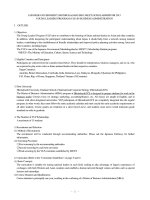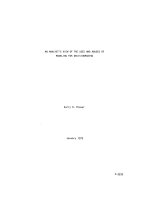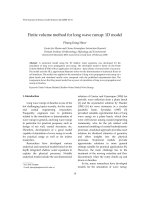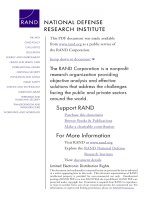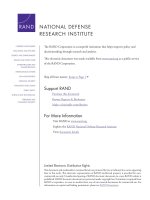Patient specific finite volume modeling for intraosseous PMMA cement flow simulation in vertebral cancellous bone
Bạn đang xem bản rút gọn của tài liệu. Xem và tải ngay bản đầy đủ của tài liệu tại đây (16.13 MB, 268 trang )
PATIENT SPECIFIC FINITE VOLUME MODELING FOR INTRAOSSEOUS
PMMA CEMENT FLOW SIMULATION IN VERTEBRAL CANCELLOUS BONE
JEREMY TEO CHOON MENG
A THESIS SUBMITTED FOR THE DEGREE OF
DOCTORATE OF PHILOSOPHY
DEPARTMENT OF DIAGNOSTIC RADIOLOGY
NATIONAL UNIVERSITY OF SINGAPORE
2007
SUMMARY
Diagnostic radiologists or orthopaedic surgeons practicing percutaneous
vertebroplasty inject viscous polymethylmethacrylate bone cement into fractured
vertebrae increasing the strength and stiffness of the vertebrae as the biocompatible
polymer hardens. The volume and spatial distribution of bone cement is currently
determined empirically. Even cement viscosity is altered to suit the working style of
the surgeon or radiologist. As with all surgical procedures, risks are implicated and it
manifests in the form of cement leakage and the subsequent fracture of adjacent
vertebrae.
Reduction in the volume of bone cement injected has been theorized to reduce
the risk of leakage as well as subsequent fractures. However, volume reduction may
also reduce the effectiveness of the percutaneous vertebroplasty procedure. Ex vivo
biomechanical tests have been used to investigate ideal cement volume and
distribution. Results are still inconclusive, as the number of parameters involved
requires substantial number of specimens, in order to be statistically significant.
Computational biomechanics offers an attractive alternative solution. Computational
models of the vertebra can be re-used to evaluate surgical parameters, eliminating
considerations inherent to specimen variation. However, current models for
percutaneous vertebroplasty are inadequate for in-depth research and are also
restricted to post-procedure stress/strain analysis. Intraosseous flow visualization is
not possible and cement distributions are generic and idealized in these models.
An improved finite volume meshing platform, using patient clinical computed
tomography datasets as input, have been developed to provide better computational
models. Also in this dissertation, through experimental means, models describing a
relationship between CT Hounsfield units, vertebral cancellous bone permeability
( ) and the viscosity – time behaviour of SimplexP
®
polymethylmethacrylate bone cement (
4.021.08.1
)(09.0)(
+!
=
tt
et
"#
&
) were determined.
These mathematical models were used as inputs for the computational simulation.
Their parameters could be altered subsequently, when more accurate models are
developed.
Percutaneous vertebroplasty simulation was performed on 4 cadaver lumbar
vertebrae specimens, which were clinically imaged both before and after bone cement
injection, using computed tomography. Image datasets before percutaneous
vertebroplasty were used to generate finite volume models and simulations were
performed according to actual procedural parameters. Based on the comparison of
bone cement filled areas in the post procedural image datasets and results from
simulation, 67.6% of the final bone cement spatial distribution could be predicted.
Unfortunately, as with all finite volume modeling, computational resources
were the main limitation in this dissertation. Clinical computed tomography datasets
had to be re-sampled to a lower resolution such that the finite volume mesh generated
would have a computationally reasonable number of elements. This also resulted in
an averaging of the CT attenuation and therefore permeability values, which was
probably detrimental to detailed modeling. The accuracy of the mathematical models
derived in this dissertation needs to be further tested experimentally as the number of
specimens was limited for economic or logistic reasons. However, it represents a
good starting ground for future work on computational modeling of intraosseous
PMMA bone cement flow. The robust nature of the modeling and simulation
framework developed through this dissertation allows these improvements to be made
more readily. In the future, finite volume meshes could eventually be generated from
higher resolution clinical CT datasets as greater computational resources become
available.
ACKNOWLEDGMENTS
My greatest appreciation and thanks to my supervisors Prof. Wang Shih
Chang and Prof. Teoh Swee Hin, for imparting knowledge, culturing my research
instinct and training of the mind. They have made my stay as their Ph.D candidate at
the National University of Singapore thoroughly fulfilling and fun at the same time.
My parents, Thank you for your prayers and for believing in me. My brothers,
nothing is impossible.
Si-hoe Kuanming, Andy Png, Bina Rai, my fellow lab mates and friends from
Biomat Center, NUSSTEP, Department of Diagnostic Radiology and Department of
Orthopedic Surgery. You have all helped me in this journey in your own special way.
It does not end here, this is just the beginning.
Finally my dearest wife Joyce, thank you for your undying love,
understanding and for not letting me quit on myself.
vii
TABLE OF CONTENTS
LIST OF TABLES xv
LIST OF FIGURES xvii
LIST OF SYMBOLS xxi
1 Introduction 1
1.1 Motivation 1
1.2 Research Scope and Objectives 4
1.3 Overview of Dissertation 6
2 Literature Review 8
2.1 Introduction 8
2.2 Anatomical Planes and Directions 8
2.3 Computed Tomography 10
2.3.1 Clinical CT Imaging 10
2.3.2 Description of Pixels and Voxels 11
2.3.3 CT Intensity and Bone Density 12
2.3.4 Micro CT Imaging and Microarchitecture 14
2.4 Basic Anatomy of the Human Spine and Vertebra 15
2.4.1 The Vertebrae and its Components 17
2.4.2 Internal structure of the vertebral body 18
2.4.3 Vertebral Venous Plexus 19
2.4.4 Intervertebral Disc 20
2.4.5 Motion Segment 21
2.5 Osteoporosis and Fractures of the Vertebra 21
viii
2.5.1 Osteoporosis of the Vertebral Body 22
2.5.2 Vertebral Compression Fractures 24
2.6 Percutaneous Vertebroplasty 26
2.6.1 History 26
2.6.2 Indications for Vertebroplasty 27
2.6.3 Percutaneous Vertebroplasty Procedure 27
2.6.4 Complications during Vertebroplasty 33
PMMA Cement Extravastion 33
Adjacent Vertebral Failure 40
2.7 Reducing Complications through Biomechanical Evaluation 42
2.7.1 Clinical Dilemma 42
2.7.2 Post-Vertebroplasty Biomechanics 43
Effects of Varying PMMA Cement Volume 44
Effects of Varying PMMA Spatial Distribution 46
2.7.3 Computational Biomechanics for Vertebroplasty Research 48
Finite Volume Method and Finite Element Method 49
Current Finite Element Mesh for Vertebroplasty 51
2.8 Finite element Modeling Techniques 55
2.8.1 Automatic Meshing Technique 55
2.8.2 Automatic Voxel-Based Meshing Technique 56
2.8.3 Adopted Finite Element Modeling Technique 60
2.8.4 Other Finite Element Modeling Considerations 62
2.9 Permeability of Cancellous Bone 62
2.9.1 Permeability and Darcy’s Law 62
2.9.2 Direct Perfusion Testing 64
2.9.3 Inference of permeability from Porosity 65
1.1.1 Inference of permeability from Porosity 66
ix
2.9.4 Increasing Vertebral Cancellous Bone Permeability Data 69
2.10 Rheology of Polymethylmethacrylate Cement 70
2.10.1 Viscosity and PMMA Bone Cement 70
2.10.2 Rheometers 73
2.10.3 Viscosity Behavior of PMMA bone cement 74
3 Permeability of Vertebral Cancellous Bone 78
3.1 Introduction 78
3.1.1 Permeability of Bone 78
3.1.2 Microarchitectural Phases on Compression 78
3.1.3 Cancellous Bone Orientation Convention 80
3.1.4 Anisotropy of Cancellous Bone and Specimen Orientation for
Permeability Testing 80
3.1.5 Measurement of Cancellous Bone Permeability 82
3.1.6 Cancellous Bone Microarchitectural Parameters 84
3.2 Materials and Methods 85
3.2.1 Cancellous Bone Permeability Testing at Various Compressive States . 85
Experimental Overview 85
Extraction of Cancellous Bone Specimens 86
Custom Permeameter Setup 87
Permeability Measurement with Custom Permeameter 88
MicroCT Imaging and Microarchitectural Analysis of Cancellous Bone 90
Mechanical Compression of Cancellous Bone Specimens 91
3.3 Results 93
3.3.1 Microarchitecture and Permeability Results of Vertebral Cancellous
Bone specimens at Each Compressed Phase 93
3.3.2 Predicting Permeability of Vertebral Cancellous Bone using Porosity 99
3.3.3 Anisotropy of Permeability in Vertebral Cancellous Bone 103
x
3.3.4 Microarchitectural Parameters that Influences Permeability of Intact
Vertebral Cancellous Bone Specimens 105
3.3.5 Improving Prediction Model Using Microarchitectural Parameters and
Multivariable Linear Regression Analyses 106
3.4 Discussion 108
3.4.1 Change in Permeability and Microarchitecture Parameters with
Compression 108
3.4.2 Microarchitectural Parameters that affect Permeability of Intact
Vertebral Cancellous Bone 111
3.4.3 Models for Predicting Permeability of Cancellous Bone 112
3.4.4 Permeability – Porosity Model based on Pooled Literature Results 113
3.5 Inferring Permeability from Clinical CT Data 115
3.6 Limitations 118
3.7 Conclusion 121
4 Rheological Study on SimplexP
®
PMMA Cement 123
4.1 Introduction 123
4.2 Materials and Methods 124
4.2.1 Rheological Testing of PMMA Bone Cement 124
Rotational Rheometer 124
Preparation and Loading of PMMA Cement 125
Testing Conditions Subjected to PMMA Cement Samples 126
4.3 Results 127
4.3.1 Shear stress vs. shear rate data of SimplexP
®
PMMA Cement at liquid
monomer to powder ratio of 1.0ml/g 127
4.3.2 Flow Index as a Function of Time 130
4.3.3 Consistency Index as a Function of Time 131
4.3.4 Viscosity (!) as a Function of Time (t) 132
4.3.5 Comparison of Models for SimplexP
®
PMMA bone Cement at
Different Liquid monomer to Powder Ratio 134
xi
4.3.6 Environmental Effects on Rheological and Mechanical Properties of
SimplexP
®
PMMA cement 135
Change in Rheological Behaviour due to Environmental Effects 135
Changes in Mechanical Behaviour 137
4.4 Discussion 138
4.4.1 Rheological Testing 138
4.4.2 Viscosity Changes due to Modification of Monomer – Powder Ratio 139
Viscosity Changes due to Radiopacifiers 140
4.4.3 Environmental Effects on Rheological and Mechanical Properties of
SimplexP
®
PMMA cement 142
Change in Rheological Behaviour 142
Changes in Mechanical Behaviour 142
4.5 Limitations 143
4.6 Conclusion 145
5 Mesh Generation for Patient Specific Vertebral Body 146
5.1 Introduction 146
5.2 Materials and Methods 147
5.2.1 Segmentation of CT Dataset 147
5.2.2 Automated Modeling for Intraosseous Flow Simulation 148
Generating the Vertebral Body Finite Volume Mesh 148
Grouping of Finite Volumes for Automatic Permeabilty Assignment 150
Smoothening of the Voxel-based Mesh 151
Clinical Decisions 154
Modifications to FE Mesh 154
Direct Implementation into Simulation 157
Overview of Developed Finite Element Meshing Process 157
5.2.3 Initial Test 159
xii
Introduction 159
Vertebral Body Geometry 159
Assigned Permeability Values of Vertebral Cancellous Bone 161
Assigned Rheological Model for PMMA Cement 162
Simulation of Intraosseous PMMA Bone Cement Flow Using CFX5.7.1 162
Exporting PMMA Distribution for Stress/Strain Analyses 163
5.3 Results 165
5.3.1 3D Spatial Distribution of PMMA Cement 165
5.3.2 Post-vertebroplasty Biomechanics 167
5.4 Discussion 169
5.5 Limitations 171
5.6 Conclusion 173
6 Case Study 175
6.1 Introduction 175
6.2 Materials and Methods 176
6.2.1 Experimental Design for Model Evaluation 176
6.2.2 Specimen Fixation and CT Imaging 177
6.2.3 Vertebroplasty on Cadaveric Vertebrae 178
Needle Position and Type 178
PMMA Bone Cement Volume and Injection Speed 180
Problem Encountered during PMMA Bone Cement Injection 180
6.2.4 Simulated Percutaneous Vertebroplasty on FV models of Vertebra 181
6.3 Results and Discussion 182
6.3.1 PMMA Bone Cement Flow Visualization 182
6.3.2 Comparison of Resultant PMMA Bone Cement Spatial Distribution 185
Spatial Distribution from Clinical CT Dataset and FV Simulation Results 185
xiii
Visual Comparison 186
Quantification of Difference between Dist
FV
and Dist
Expt
189
6.3.3 Simulating Fractures in a Vertebral Body 190
6.3.4 Vacuum Clefts 192
6.3.5 Meshing Considerations for Fracture Planes and Vacuum Clefts 193
6.4 Limitations 194
6.5 Conclusion 196
7 Conclusion and Recommendations 197
7.1 Conclusion 197
7.2 Future Work 199
7.3 Publications 200
References 201
Appendix A. New York Times Article on Vertebroplasty 218
Appendix B. Principles of CT Imaging 220
Appendix C. Extraction of cancellous bone specimens 222
Appendix D. Assembly of Permeameter 224
Appendix E. Permeability Values from other investigators 231
Appendix F. Hounsfield Unit and Porosity of Porcine Cancellous Bone 235
Appendix G. Description of Microarchitectural Parameters 236
Appendix H. Permeability and Microarhictecture Results 239
Appendix I. Centroid of Complex Solids 248
xv
LIST OF TABLES
Table 1 Description of anatomical directions 9
Table 2 Quantified difference between healthy and osteoporotic human lumbar
vertebra [Mosekilde, 2000]. 24
Table 3 Results from ex vivo compression tests from other investigators 48
Table 4 A comparison of geometrical conformance of all-hexahedral and all-
tetrahedral FE models. 60
Table 5 Permeability values from various investigators. 68
Table 6 Consistency, CI, and flow, FI, index for several commercially available
PMMA cement. 76
Table 7 Permeability and microarchitectural parameters of longitudinal and transverse
cancellous bone specimens at each compressed phases 94
Table 8 Correlation coefficients obtained from univariate linear regression analyses
between k and cancellous bone microarchitectural parameters 106
Table 9 Univariable and multivariable linear models for predicting permeability (k) 107
Table 10 Prediction models for permeability of cancellous bone 114
Table 11 Summary of enviromental conditions subjected to SimplexP
®
PMMA bone
cement during rheological testing 127
Table 12 Flow and consistency indices at several time intervals 129
Table 13 Flow index (FI), consistency (CI) and viscosity (!) values for SimplexP
®
PMMA bone cement at different liquid monomer - PMMA powder ratios and
time points. 134
Table 14 Consistentcy index (CI), flow index (FI) and correlation coefficients (R
2
) of
SimplexP
®
PMMA bone cement with changed environmental factors. 136
Table 15 Needle placement positions used in the initial test 160
Table 16 Ratios used to obtain mechanical properties of bone for stress/strain
analyses. 165
Table 17 Visualization of intraosseous PMMA distribution for 1.0ml and 5.0ml of
PMMA cement injected. 166
xvi
Table 18 Von Misese stress distributions due to physiological loading on augmented
vertebral bodies with varying spatiatl distributions of PMMA bonec cement 168
Table 19 Needle tip position for experimental vertebroplasty 179
Table 20 Time-lapse images of intraosseous 3D PMMA bone cement distribution for
bi-pedicular injection into the L1 and L2 vertebral bodies. 183
Table 21 Time-lapse images of intraosseous 3D bone PMMA cement distribution for
bi-pedicular injection into the L3 and L4 vertebral bodies. 184
Table 22 Sagittal and coronal plane images of registered Dist
FV
and Dist
Expt
for visual
comparison. 188
Table 23 Predicitability of experimental PMMA cement distribution using
computational flow dynamics 190
Table 24 Time lapse images of intraosseous 3D PMMA bone cement distribution for
uni-pedicular injection into a vertebral body without (left) and with (right) a
fracture plane 191
xvii
LIST OF FIGURES
Figure 1 Percutaneous Vertebroplasty procedure. 3
Figure 2 Use of computational fluid dynamics (CFD) simulation for the study of
groundwater flow in geosciences 5
Figure 3 Anatomical planes and directions 10
Figure 4 Clinical computed tomography (CT) scanner 11
Figure 5 Clinical CT intensity and vertebral cancellous bone 14
Figure 6 Regions and curvature of the human spine. 16
Figure 7 Anatomical components of a typical human vertebra. 18
Figure 8 Internal structure of the vertebral body. 19
Figure 9 Vertebral venous plexus 20
Figure 10 Intervertebral (IV) disc of the human spine 21
Figure 11 Comparison of internal microarchitecture between a healthy and
osteoporotic human vertebral body 23
Figure 12 Compression fractures of the human vertebral body 26
Figure 13 Vertebroplasty procedure is usually performed with patient prone. 29
Figure 14 Fluoroscopy guidance of bone needle insertion during Vertebroplasty. 30
Figure 15 Fluoroscopic images of vertebral bodies injected with radio-opaque
polymethylmethacrylate (PMMA) bone cement. 32
Figure 16 Polymethylmethacrylate (PMMA) bone cement extravasation and
migration to other anatomical structures 36
Figure 17 The kyphoplasty procedure is a variant of vertebroplasty using a balloon 39
Figure 18 Clinical case study of an adjacent vertebral fracture after vertebroplasty 40
Figure 19 Evaluating post-vertebroplasty biomechanics of cadaver vertebral bodies 45
Figure 20 Parametric evaluation of post-vertebroplasty biomechanical efficiency with
different 3D spatial distribution of PMMA bone cement 47
xviii
Figure 21 Discretization of physical objects into finite element models or meshes 50
Figure 22 Current finite element (FE) meshes employed for post-vertebroplasty
biomechanical evaluation developed by other investigators 54
Figure 23 Voxel-based finite element models of various anatomical structures. 59
Figure 24 Assignment of appropriate material properties to finite element models 61
Figure 25 Permeameters used for measuring cancellous bone permeability 65
Figure 26 Pooled permeability values digitized and compiled from other
investigators 67
Figure 27 Schematic explanation of viscosity. 71
Figure 28 Rheological models used to describe fluid viscosity 73
Figure 29 Compressed phases of cancellous bone. 79
Figure 30 Volume rendered images of trabeculae and intratrabecular pore spaces 81
Figure 31 Flow diagram for the experimental testing performed to determine the
effects of compression on permeability of cancellous bone. 85
Figure 32 Extraction of vertebral cancellous bone specimens 87
Figure 33 Schematic of custom falling head permeameter used for permeability
measurement of vertebral cancellous bone specimens. 89
Figure 34 Typical stress - strain curve for vertebral cancellous bone specimen under
compression 91
Figure 35 Compression jig for cancellous bone specimens 93
Figure 36 Change in vertebral cancellous bone specimens at the respective
compressed phase. 99
Figure 37 Graph of pooled permeability and porosity scatter plot for extracted intact
vertebral cancellous bone specimens. 100
Figure 38 Graph of pooled permeability vs. porosity scatter plot for extracted
vertebral cancellous bone specimen. 101
Figure 39 Graph of pooled permeability vs. porosity scatter plot for longitudinal
intact vertebral cancellous bone specimens extracted for this dissertation and
from literature 102
Figure 40 Graph of pooled permeability vs. porosity scatter plot for longitudinal and
transverse cancellous bone specimens extracted for this dissertation and from
literature. 102
xix
Figure 41 Velocity streamlines across simplified longitudinal and transverse pore
spaces. 104
Figure 42 Relationship between clinical CT Hounsfield to porosity of vertebral
cancellous bone 117
Figure 43 Parallel plate setup on the C-ARES 100/100FRT rotational rheometer 125
Figure 44 Graph of shear stress vs. shear rate data at several time intervals, for
SimplexP
®
PMMA cement mixed at liquid monomer to PMMA powder ratio
of 1.0ml/g. 128
Figure 45 Graph of log (shear stress) vs. log (shear rate) data at several time intervals,
for SimplexP
®
PMMA bone cement mixed at liquid monomer to PMMA
powder ratio of 1.0 ml/g 129
Figure 46 Graph of flow index vs. time data, for SimplexP
®
PMMA bone cement
mixed at liquid monomer to PMMA powder ratio of 1.0ml/g. 131
Figure 47 Graph of Consistency index vs. time data, for SimplexP
®
PMMA bone
cement mixed at liquid monomer to PMMA powder ratio of 1.0ml/g. 132
Figure 48 Graph of viscosity (
!
) vs. time (t) data, for SimplexP
®
PMMA bone cement
mixed at liquid monomer to PMMA powder ratio of 1.0ml/g, when subjected
to rheological testing at a shear rate of 0.1, 1.0 and 10.0 s
-1
. 133
Figure 49 Polymethylmethacrylate (PMMA) bone cement rheological models at
different liquid monomer – powder ratio 135
Figure 50 Graph of log (shear stress) vs. log (shear rate) data for SimplexP
®
PMMA
bone cement mixed at liquid monomer to PMMA powder ratio of 1.0 ml/g,
when subjected to different environmental conditioning 136
Figure 51 Stainless steel mold used to produce PMMA cement plugs for mechanical
testing. 137
Figure 52 Compressive modulus and strength for polymerized PMMA bone cement 138
Figure 53 Changes in Rheological Behavior due to Addition of Radiopacifier to
Polymethylmethacrylate (PMMA) Bone Cement 141
Figure 54 Schematic representation and actual segmentation of computed
tomography (CT) image datasets 148
Figure 55 Conversion of a 2D image and 3D image datasets into planar and
volumetric finite elements 149
Figure 56 Automated grouping of elements based on threshold value. 150
Figure 57 Determining centroids of elements found at the surface of a finite volume
(FV) mesh 152
xx
Figure 58 Illustration of the mesh smoothening process in 2D. 153
Figure 59 Smoothening algorithm for elements found on the surface of an all-
hexahedral finite volume (FV) mesh. 153
Figure 60 User interface for needle positioning and the export of needle coordinates 155
Figure 61 Creation of new CT dataset with selected needle placement 156
Figure 62 Implementation of a fluid with operator-specific parameters in CFX 5.7.1 157
Figure 63 Method of generating patient-specific finite volume (FV) mesh of the
vertebral body from CT images for flow simulation. 158
Figure 64 Groups of hexahedral elements automatically assigned during the finite
element modeling process. 161
Figure 65 Conditions for simulated vertebroplasty injection using computational fluid
dynamics (CFD) 163
Figure 66 Effects of needle position and polymethylmethacrylate bone cement volume
on stiffness ratio 167
Figure 67 Experiment designed to compare post-Vertebroplasty PMMA bone cement
distribution 177
Figure 68 Radiographs of the cadaveric lumbar segment, in the lateral (left) and
coronal (right) plane, with needle placed in their desired positions. 179
Figure 69 Segmented PMMA cement distribution from post-vertebroplasty clinical
CT dataset 186
Figure 70 Schematic of comparative area analysis between corresponding images
from experiments and simulation. 189
Figure 71 Pre- and Post-Vertebroplasty Radiographs of vacuum cleft 193
xxi
LIST OF SYMBOLS
Name
Symbol
Units
Page First Mentioned
Bone Surface Density
BS/TV
mm
-1
84
Bone Volume Fraction
BV/TV
n.a.
21
Consistency Index
CI
n.a.
70
Cross sectional Area
A
m
2
60
Density
"
kg m
-3
80
Diameter
D or d
m
81
Dynamic Viscosity
!
or µ
Pa s
60
Flow Index
FI
n.a.
84
Fluid Velocity
u
m s
-1
79
Gravitational Acceleration
g
m s
-2
80
Grayscale Intensity
GS
n.a.
32
Hydraulic Conductivity
K
m s
-1
62
Hydraulic Head
h
m
29
Modulus of Elasticity
E
Pa
161
Permeability
k
m
2
79
Porosity
"
n.a.
62
Pressure
P
Pa
60
Shear rate
!
&
s
-1
68
Shear stress
#
Pa
68
Specimen Length
L
m
60
Structure Model Index
SMI
n.a.
84
Time
t
s or min
66
Volumetric Flow Rate
Q
m
3
s
-1
60
xxii
Yield Strain
$
yield
n.a.
75
Yield Stress
%
yield
Pa
75
Trabecular Bone Thickness
Tb.Th
mm
84
Trabecular Number
Tb.N
mm
-1
84
Trabecular Pattern Factor
Tb.Pf
mm
-1
84
Trabecular Separation
Tb.Sp
mm
84
1
1 Introduction
1.1 Motivation
Osteoporosis is the gradual decline in bone mass and bone quality with
increasing age. This progressive decrease results in increased bone fragility and
susceptibility to fractures. It has been projected that in Singapore, from the year
2000 to 2030, there will be a 372% increase in the population of Singaporeans
aged above 65 [Ministry of Health, Singapore, 2003]. As with all aging
populations, osteoporosis poses a major public health threat. The World Health
Organization in 2001 reported the prevalence of women having osteoporosis to be
8% for women between ages 60-69 years, 25% for women between ages 70-79
years, and 48% for women above the age of 80 years [Lin et al., 2001]. The
burden of osteoporosis lies not only in the hospitalization from fractures, but also
morbidity that arises from a lowered quality of life, increased disability, and
reduced independence.
Osteoporotic fractures frequently occurs with minimal or no trauma. Many
a time, the fractures occur during normal daily activities, activities that subject the
spinal column to compressive physiological loads. In the United States alone, of
the 1.5 million osteoporotic fractures reported annually, approximately half were
vertebral compression fractures (VCF). Progressive or immediate vertebral
collapse was inherent after fracture, causing vertebral column instability.
Conservative treatment of VCF involves a combination of rest, external support of
the spinal column, anti-inflammatory agents and analgesics. Unfortunately, some
patients do not respond well to these treatments. Invasive surgical procedures,
involving internal fixation and stabilization are not feasible, as osteoporotic
2
patients have bone too porous to provide robust anchoring for spinal
instrumentation. Age of patients is also a consideration against surgery.
Percutaneous vertebroplasty or simple vertebroplasty, is the augmentation
of fractured vertebrae using polymethylmethacrylate (PMMA) cement, is an
alternative treatment for VCF, and is fast gaining popularity. This popularity is
driven partly by patients experiencing rapid and tremendous relief from pain and
some are completely pain free after treatment. Vertebroplasty involves the
fluoroscopy-guided insertion of a hollow bone needle through the skin, into the
fractured vertebrae via the pedicles, and the subsequent injection of viscous
PMMA cement (Figure 1). Patients are to remain in a sedentary state until the
solidification of the biocompatible PMMA cement.
As with all surgical procedures, complications may occur. PMMA cement
extravasation is the main source of clinical complications, if the cement leaks or
extravates beyond the fractured vertebra and into the surrounding regions.
Another post-surgery complication is in the form of failure of adjacent non-
augmented vertebral bodies. This is caused by a ‘stress-riser’ effect and a
significant difference in biomechanical properties between the two adjacent
vertebrae.
3
Figure 1 Percutaneous Vertebroplasty procedure.
Vertebroplasty involves the fluoroscopy-guided insertion of a hollow bone
needle through the skin, into the fractured vertebrae via the pedicles, and the
subsequent injection of viscous PMMA cement. Patients are to remain in a
sedentary state until the solidification of the biocompatible PMMA cement.
Image reproduced from www.ubneurosurgery.com.
Currently, the volume and spatial distribution of PMMA cement injected is
empirical, guided only by experience of the diagnostic radiologist or surgeon
performing the procedure [Peh and Giula, 2005]. Lowering the amount of volume
injected may result in a reduction of PMMA cement leakages and the
biomechanical disparity between adjacent augmented and non-augmented
vertebrae. This could however compromise the biomechanical stabilization effect
from vertebroplasty.
Several investigators have performed bench top studies to evaluate the
biomechanical effects of varying PMMA cement volume and different PMMA
cement spatial distribution within a single vertebra. Such experimental
investigations require a large number of specimens in order to demonstrate
statistical significance. In addition, biological variability is minimized only if
ample specimens are used.
4
Computational simulations used to mimic these experiments are therefore
an attractive alternative approach. A single computational ‘specimen’ can be
reused indefinitely, facilitating parametric studies on the biomechanics of
vertebroplasty. After an exhaustive literature search, it has been ascertained that
only four major groups employed the finite element method (FEM) to study post-
vertebroplasty biomechanics computationally. However, the finite element (FE)
models remain inadequate and despite having these preliminary computational and
experimental biomechanical investigations, percutaneous vertebroplasty still lacks
prospective, randomized and controlled trials to characterize the long-term safety
and effectiveness of the procedure. For these reasons, the procedure is still not
approved by the United State’s Food and Drug Administration; all this despite
vertebroplasty becoming the treatment of choice for persistently painful
osteoporotic vertebral fractures. The volume filled and spatial distribution of
PMMA bone cement for each vertebra should have more science to it, instead of
being an ‘art form’.
1.2 Research Scope and Objectives
It is hypothesized that engineering computational fluid dynamics (CFD),
employing the finite volume (FV) method, is capable of providing both patient-
specific visualization and prediction of PMMA bone cement flow path as well as
spatial distribution that can be used for post-vertebroplasty stress/strain analyses.
Similar to stress/strain analysis of augmented vertebral bodies, simulating
intraosseous PMMA bone cement flow can adopt two approaches: (a) model the
intricate microstructure of cancellous bone or (b) model the cancellous bone as a
solid, with properties reflecting its porosity. For intraosseous PMMA bone cement
flow simulation using CFD, a complete three dimensional (3D) FV mesh of the
5
vertebral body is required. Micro-scaled computational meshes, which factor the
cancellous bone intricate microstructure, currently require unrealistic
computational resources and time.
The use of computational simulations to study the flow of water through
different types of soils has been well documented [Diersch and Kolditz, 2002; Das
et al., 2002; Muccino et al., 1998]. In these models, elements that represent soil
have physical information in the form of permeability assigned to them (Figure 2).
Permeability refers to the propensity of a solid to allow fluid to move through its
pores or interstices. Experts in the cellular solid field categorized cancellous bone
as an open-celled porous solid [Gibson, 2005]. In this dissertation, it has been
assumed that PMMA bone cement flow through porous cancellous bone is
analogous to water flowing through soil.
Figure 2 Use of computational fluid dynamics (CFD) simulation for the
study of groundwater flow in geosciences.
Computational fluid dynamics (CFD) employing Finite Volume Method
(FVM) have been used to predict groundwater flow. In all FVM
simulations, a finite volume (FV) mesh must first be generated and this
usually involves the discretization of the physical domain, as shown in the
figure above. After which, a FV model is obtained when properties,
boundary conditions and loading conditions are assigned. Image reproduced
from www.rockware.com.
